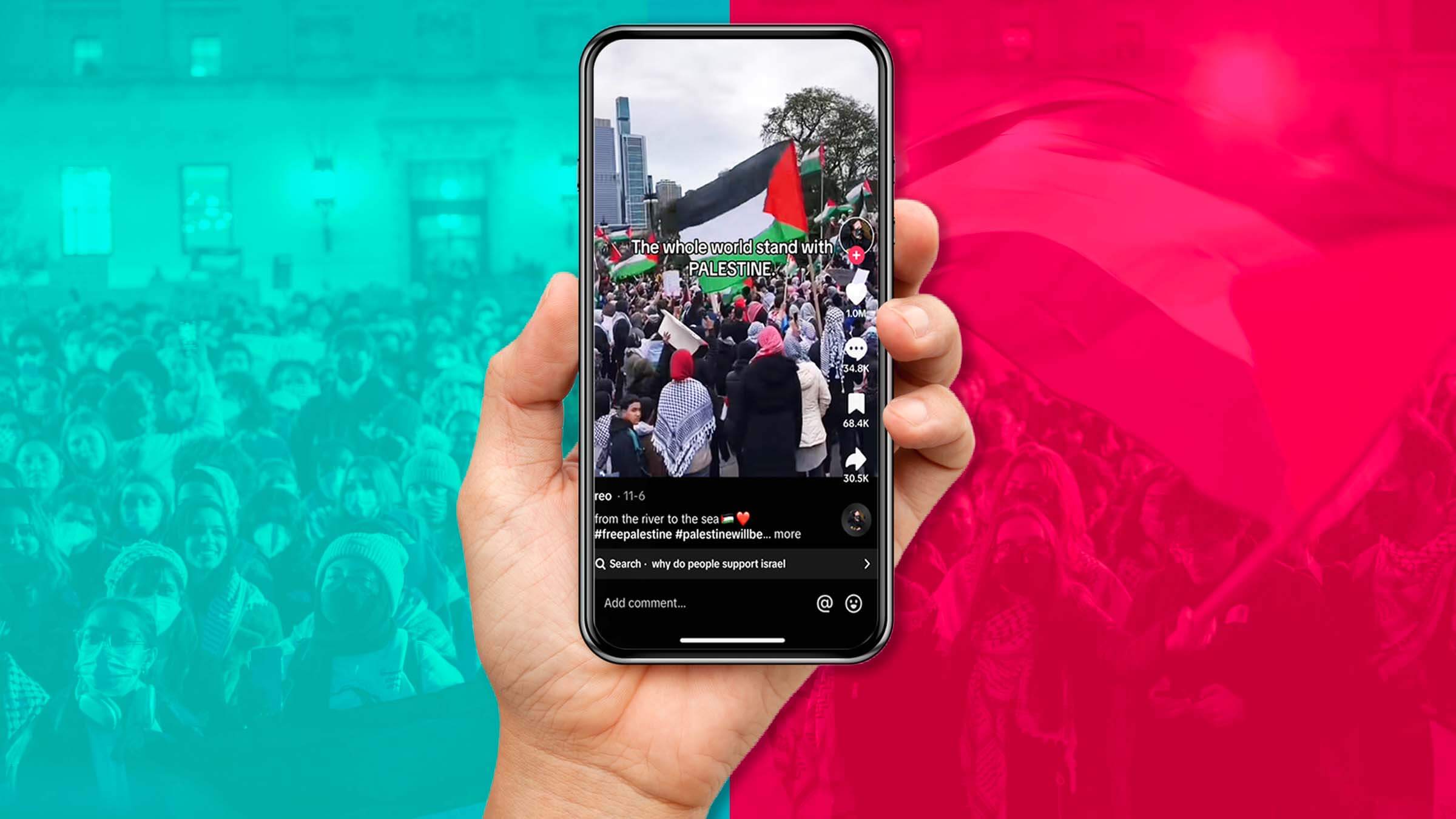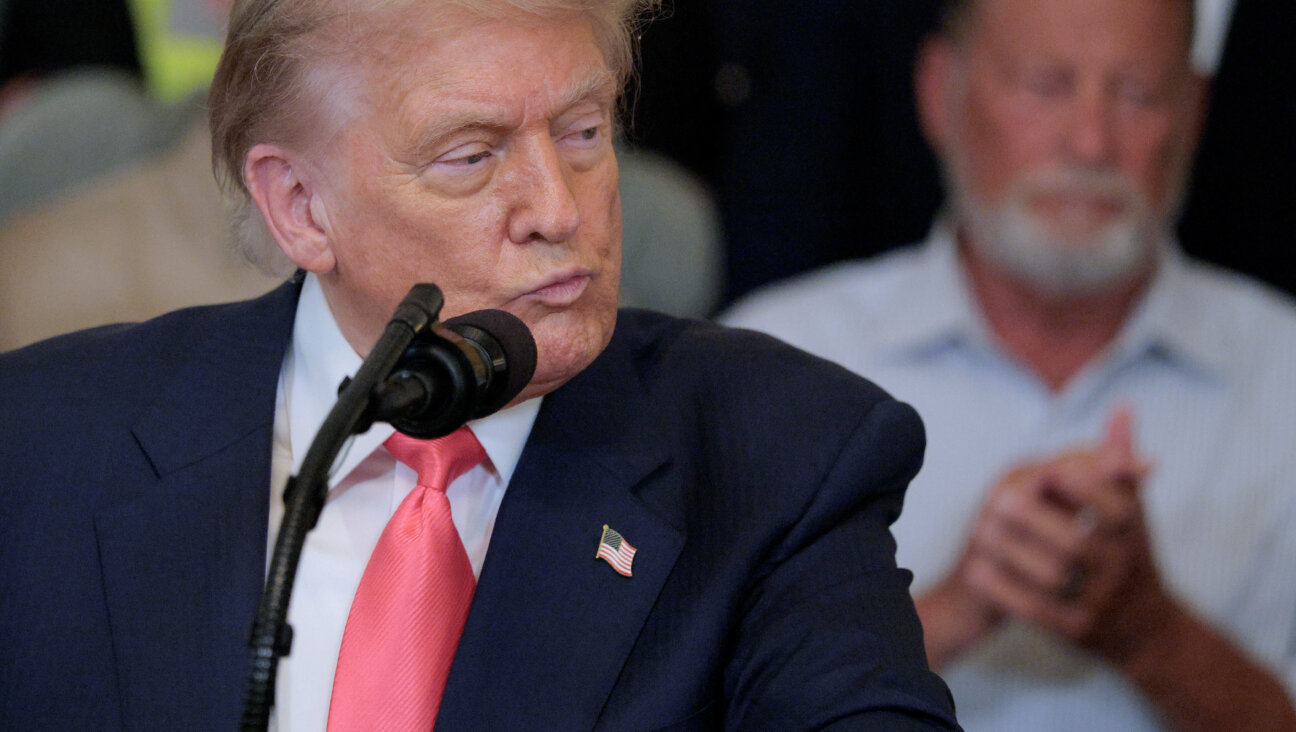Young Americans are turning against Israel — and you can thank TikTok
New analyses show that pro-Palestinian content dwarfs all others on the app, and China is likely making it worse

A user holds a cellphone displaying a pro-Palestinian TikTok video. Photo by Forward montage
If you’re not worried about TikTok yet, you should be.
The conspiracy–superspreading platform is not just wreaking havoc on the self-esteem of young people and dominating hours of their day. There is also increasing evidence that the app, and the country behind it, deliberately funnels young Americans content specifically designed to foment geopolitical instability and anti-Israel sentiment.
A new report out today from the National Contagion Research Institute, which studies the spread of online hate, reveals substantial evidence that content on TikTok is “promoted or muted” depending on “whether it is aligned or opposed to the interests of the Chinese government.”
In other words, as one expert privately put it, China is using TikTok to protect their investments. And those investments include interests in Arab countries antagonistic to the Jewish state.
Journalists at The Wall Street Journal recently conducted an experiment signing up for TikTok accounts as a 13-year-olds and found that within hours, the app began feeding them apocalyptic, conspiratorial and “highly polarized content, reflecting often extreme pro-Palestinian or pro-Israel positions.” A majority of the posts shown “supported the Palestinian view,” the journalists said. Even after they put an account in restricted mode, “the account’s feed was almost entirely dominated by vivid images and descriptions of the conflict.”
Of the eight test accounts the Journal created, five were served primarily conflict-related videos within the first 100 posts.
China occupies a tricky position — of its own making — on the Israeli-Palestinian conflict. The country long supported Palestinian liberation movements, even arming and training PLO militants, but has tried to play both sides since it began normalizing relations with Israel in the 1980s and ’90s.
The Xi regime has not condemned the Oct. 7 attacks in which Hamas killed some 1,200 people in Israel, despite maintaining fairly close ties with the Jewish state. It has also called for a cease-fire and increased humanitarian aid to Gaza and advocated a two-state solution.
In its quest to replace the United States as a global superpower, China is presenting itself as an anti-Western peacemaker and champion of the oppressed, hoping to secure clout during the Israel-Hamas war even as it perpetuates a genocide against the Uyghur Muslims who reside closer to home.
It is particularly invested in deepening relationships with Russia, Iran and Arab nations. And as a June article from the Wilson Center soberingly put it, China’s “complete disregard for human rights and individual freedoms seems to attract many regional governments.”
Rorry Daniels, the managing director of the Asia Society Policy Institute, said in a recent article in The Guardian that there is little the Chinese government can safely do publicly right now to support the Palestinian cause beyond “cost-free” gestures of “rhetorical support” for the humanitarian crisis in Gaza. “Anything more creates a tricky set of consequences that I would assume China seeks to avoid,” she said.
“Publicly” is the key word. Because there is ample evidence that the Chinese government has long fomented anti-Jewish and anti-Israel sentiment in state-controlled channels.
“It is hard to say whether the anti-Israeli positions in state media and antisemitism on the Chinese internet are part of a coordinated campaign,” acknowledged a recent analysis in The New York Times. “But China’s state media rarely veers from the official position of the country’s Communist Party, and its hair-trigger internet censors are keenly attuned to the wishes of its leaders, quick to remove any content that sways public sentiment in an unwanted direction, especially on matters of such geopolitical importance.”
The picture of state-influenced media is incomplete if it does not include TikTok, where anti-American sentiment and antisemitism have long been an issue and where large swaths of young people get most of their news.
How hate serves Chinese interests
Those invested in the future of democracy ignore potential social media manipulation — not to mention the fomenting of riots and conspiracy theories run amok — at their own peril. Last month, TikTok videos praising Osama bin Laden’s antisemitic and anti-Western “Letter to America,” for example, went viral.
A poll published in the Times this week found that 35% of voters aged 18-29 get their news primarily from social media, and 44% use TikTok “often.” That same poll showed that 48% in that age group believe Israel is intentionally killing civilians in Gaza and 55% oppose providing further aid to Israel.
It’s always hard to discern correlation from causation, and TikTok likely reflects young people’s opinions as well as sways them.
The brutal violence of the war itself, broadcast live in high-definition for all to see, certainly does not help. But we also know that pro-Palestinian posts dwarf pro-Israel ones on the platform, and that “those who identify as regular users of TikTok were the most adamant in their criticism” of Israel, according to the Times. “Even when controlling for their age, TikTok users were more critical of the Biden administration’s policies toward Israel.”
#FreePalstine goes viral
I pulled data from TikTok’s analytics platform for the 30 days preceding Dec. 21 to get a more granular view of this phenomenon. It’s clear that pro-Palestinian videos were viewed far more often than content on virtually any other topic, though TikTok’s public ranking of the top 100 hashtags curiously leaves it out.
#FreePalestine was used in 214,000 videos posted to TikTok from the United States over the past month, and those videos were viewed 525 million times, according to TikTok’s publicly available data. Globally, the hashtag was used in 1 million videos that were viewed 4 billion times. In Arabic, a hashtag saying simply #Palestine was used in 895,000 videos viewed 7 billion times (24,000 of these were posted within the U.S., garnering 90 million views).
During the same 30 days, the most popular pro-Israel hashtag on the site, #standwithIsrael, appeared in 3,000 U.S. videos that were viewed 17 million times. Globally, there were 13,000 videos that were viewed 109 million times.
TikTok’s Top 100 list was notably devoid of Palestine and Israel, and any other political topics, instead seeming to center on Christmas, various viral challenges and the new Willy Wonka movie. But if it had been ranked, #freepalestine would have ranked No. 1 by a landslide.
The top-ranked U.S. tag, “#iautocompleteia,” was used in 78,000 U.S. posts and viewed 413 million times. The top-ranked global tag, “#navidadentiktok,” was used in 19,000 videos viewed 163 million times. The company has not yet responded to an inquiry about why #freepalestine — whose videos and views were astronomically higher — were not included in these ranked lists.
In a Nov. 13 post defending the platform’s content-moderation policies, TikTok cited similarly lopsided ratios of far more pro-Palestinian than pro-Israel posts on other platforms. On Instagram, “there are 5.7 million total posts tagged #FreePalestine compared to 214,000 total posts tagged #standwithIsrael,” the company wrote. “Looking at public Facebook data, there are 11 million total posts tagged #FreePalestine compared to 278,000 total posts tagged #standwithIsrael.”
What this response fails to note is the dramatic difference in the volume of pro-Israel posts on Instagram and TikTok. Though pro-Palestinian tags are used more frequently than pro-Israel ones on all three platforms, NCRI’s new report shows that there have been roughly six times as many pro-Israel hashtagged posts on Instagram since its launch in 2010 than there have been over TikTok’s seven years of existence.
Even content with hashtags like “BringThemHome” and “HamasIsISIS” that were popularized after Oct. 7 are much more frequently seen on Instagram. Though demographic differences among users may play some role, similar percentages of American teens say they use both platforms daily.
The resulting distortion is striking, and it’s only getting worse. On Dec. 20, ADL officials told me that their Center for Tech and Society researchers “found that bad actors are circumventing content-moderation safeguards put in place by TikTok to spread vile and blatant antisemitism and to connect with fellow travelers on the platform.”
In the same Nov. 13 letter, addressing “hashtags and content during the Israel-Hamas war,” TikTok said that it has “removed more than 24 million fake accounts globally and more than half a million bot comments on content under hashtags related to the conflict,” pointing to the influence of outside actors interested in moving public opinion on this matter.
In the first three weeks of the war, TikTok said it also removed 730,000 videos that violated rules on hateful behavior, and an additional 925,000 “in the conflict region for violating our policies around violence, hate speech, misinformation, and terrorism, including content promoting Hamas.”
It’s probably making little difference.
If TikTok is to continue to operate in this country, it needs to open up the black box.
ADL gave TikTok an “F” for data accessibility in 2021, the worst among all platforms it ranked, and little has changed since then. The company’s research API, launched this year, places onerous burdens on would-be analysts and bars civil society organizations, including ADL, from full access.
What gets measured gets managed, as the old saying goes. It’s time for U.S. policymakers to stop whining about TikTok and do something about it.
























